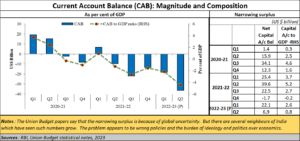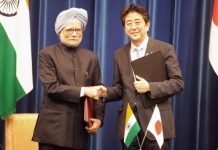A hollowed-out India needs an economic reboot
By RN Bhaskar
 Hollowed-out is a phrase that refers to something being taken out, leaving the shell to be filled with anything or nothing. India is being hollowed out. Its ability to be entrepreneurial is being driven away. Thousands of wealthy Indians are leaving India and almost two lakh Indians surrendering their passports each year (more on this later. It is being filled with ideology and with crass policies that will only harm India’s ability to be self-reliant and prosperous.
Hollowed-out is a phrase that refers to something being taken out, leaving the shell to be filled with anything or nothing. India is being hollowed out. Its ability to be entrepreneurial is being driven away. Thousands of wealthy Indians are leaving India and almost two lakh Indians surrendering their passports each year (more on this later. It is being filled with ideology and with crass policies that will only harm India’s ability to be self-reliant and prosperous.
At one level, India loves to talk about the need to strengthen education, skill development, high technology, and digital public infrastructure. This is what happened at the G-7 metings. “Leaders discussed ways to further strengthen the bilateral Special Strategic and Global Partnership. Education, skill development, tourism, high technology and digital public infrastructure were covered,” stated the Ministry of external affairs (MEA) (https://www.thehindu.com/news/national/pm-modi-holds-meeting-with-japanese-counterpart-kishida/article66872999.ece).
On the other, back in India, education continues to languish. Many schools don’t have more than one teacher. A large number of schools don’t even have science laboratories (https://bhaskarr.substack.com/p/the-state-of-education-in-india Subscription to the author’s substack is free of cost). The situation is made worse when you realise that the contagion appears to have spread to higher education as well — especially to the IITs which are the apex institutions for engineering and technology in this country — https://bhaskarr.substack.com/p/the-state-of-higher-education-in?sd=pf. So does healthcare. India is nowhere among the top three when it comes to either education or healthcare. It has short-sold its demographic dividend (https://bhaskarr.substack.com/p/india-population-and-economic-growth). And the penchant the government has for shutting down the internet more often than any other country affects not only route business which is being digitised rapidly, but also education. Today, India has become the internet shutdown capital of the world (https://www.dw.com/en/india-internet-shutdown-capital-of-the-world/a-64997062).
Creaking digital
And when it comes to digital public infrastructure, India has three giant problems.
First the entire architecture is creaking and riddled with problems. For instance, it was discovered that the system could easily be hacked into (https://www.huffpost.com/archive/au/entry/uidai-s-aadhaar-software-hacked-id-database-compromised-experts-confirm_au_5cd38b41e4b0acea9502f056 and then watch this https://www.youtube.com/watch?v=j5E71Y2n5Q4 and also go through this https://www.bleepingcomputer.com/news/security/illegal-patch-allows-easier-access-to-indias-aadhaar-biometric-database/). Listen to the chatter among IT professionals, and you discover this the system was designed to allow hackers to add data, and not just steal data from it. Terribly bizarre and frightening.
 Second, listen to the discussions in Parliament, and you discover that the Aadhaar system has been created to add numbers, and not deduct them. That is why the government claims it cannot delete Aadhaar numbers of people who are dead! Equally perplexing and worrisome.
Second, listen to the discussions in Parliament, and you discover that the Aadhaar system has been created to add numbers, and not deduct them. That is why the government claims it cannot delete Aadhaar numbers of people who are dead! Equally perplexing and worrisome.
Third, go through the letter that E A S Sarma, former secretary to the government of India recently wrote to the CAG, requesting an urgent audit of the digital infrastructure relating to Aadhaar, elections and the distribution of money under the Centrally Sponsored Schemes (CSSs) (https://asiaconverge.com/2023/05/a-complaint-letter-to-the-cag-by-eas-sarma/). That is when you realise that there are huge implications for the country’s exchequer, its electoral rolls and even its very definition of citizenship. The last problem has huge implications for India’s internal security.
Unfortunately, most of India’ policy makers have not flagged these issues.
Collectively, all of them have implications for India’s economy. The leaky Aadhaar structure allows for more money to be released into India’s economy than warranted (more on subsidies can be found below). That in turn leads to higher GST collections (https://asiaconverge.com/2023/05/india-has-gst-and-gdp-gas-balloons/. They also allow for people to believe that tax collections are indeed robust, and that its GDP is impressive though they have been propped up through borrowed funds. That in turn causes a further erosion of the Indian rupee on the one hand and a higher inflation on the other.
Ideology over economics
The problem is compounded when decisions get taken based on ideology and politics rather than economic soundness. Three examples stare into your face to confirm such suspicions.
 The first is the rash move towards cattle slaughter sentiments – thus affecting even those who deal with buffaloes and not cows (https://asiaconverge.com/2023/01/sodhis-resignation-has-dire-warnings-for-agriculture-and-milk/). The problem is more pervasive in the Hindi speaking belt. But then, that is the part of India which has seen poor education, poor revenue generation, poor per capita electricity consumption and even poor law and order. As a result, leather, which is both labour intensive and a big export item for India, has continued to languish. Linked to the cattle slaughter laws is the scant regard that the government seems to have for the agricultural sector. Futures in commodity trading has been banned for more crops than ever before. That in turn worsens farmer distress. That reduces rural purchasing power which in turn cripples demand and hurts industry. The government’s answer is to provide more subsidies to rural folk. But that, like drug addiction, makes people less self-reliant, Moreover, subsidies eventually cripple the efficient, and reward the inefficient. In fact subsidies could hurt the nation (https://economictimes.indiatimes.com/news/economy/finance/poll-freebies-to-hurt-long-term-growth-say-experts/articleshow/100236680.cms?from=mdr). When the country ignores its core strengths and seeks new strengths, without really having the export clout, there is trouble ahead. No wonder, India’s balance of trade has been worsening year after year.
The first is the rash move towards cattle slaughter sentiments – thus affecting even those who deal with buffaloes and not cows (https://asiaconverge.com/2023/01/sodhis-resignation-has-dire-warnings-for-agriculture-and-milk/). The problem is more pervasive in the Hindi speaking belt. But then, that is the part of India which has seen poor education, poor revenue generation, poor per capita electricity consumption and even poor law and order. As a result, leather, which is both labour intensive and a big export item for India, has continued to languish. Linked to the cattle slaughter laws is the scant regard that the government seems to have for the agricultural sector. Futures in commodity trading has been banned for more crops than ever before. That in turn worsens farmer distress. That reduces rural purchasing power which in turn cripples demand and hurts industry. The government’s answer is to provide more subsidies to rural folk. But that, like drug addiction, makes people less self-reliant, Moreover, subsidies eventually cripple the efficient, and reward the inefficient. In fact subsidies could hurt the nation (https://economictimes.indiatimes.com/news/economy/finance/poll-freebies-to-hurt-long-term-growth-say-experts/articleshow/100236680.cms?from=mdr). When the country ignores its core strengths and seeks new strengths, without really having the export clout, there is trouble ahead. No wonder, India’s balance of trade has been worsening year after year.
Translocation of industries
The second is the manner in which the government has sought to move industries out of one geographical region to another to suit politics (https://asiaconverge.com/2023/03/india-tries-to-regain-its-balance/). For instance, the government has shifted to Gujarat the International Finance Centre or the IFC (though Mumbai was meant to house it since it is the financial centre of the country). Then it was gold. The gold bourse is now located in Gujarat. Then it was the turn of diamonds. Surat is the new hub which is being promoted. Nothing wrong with competition. But when sectors are sought to be translocated from the regions where an entire eco-system exists, there are bound to be labour upheavals, and even disruption in economic growth. Not surprisingly, Surat is now witnessing a glut in diamond production, causing it to work only four days a week, and for four hours on those days. Disrupting economic centres of excellence within the same country can prove to be disastrous for both the workforce and the industry. Today, the IFC (in Gujarat) continues to languish despite all the incentives the centre has provided it. Thus, neither has Mumbai’s role as the country’s financial centre been strengthened, nor has the new location lived up to its expectations. The loser is the country.
The new Licence Raj
The third example is the production linked incentive (PLI) scheme (http://www.asiaconverge.com/2021/03/india-may-be-pushing-a-wrong-trade-policy/). Even industrialists like Rajiv Bajaj have been critical of such a scheme (https://www.business-standard.com/companies/interviews/ev-subsidies-flawed-and-unfeasible-says-bajaj-auto-md-rajiv-bajaj-123051801336_1.html). The PLI has become another method for granting favours to specific industries and industrialists, some terribly misplaced. It is rapidly becoming a new form of licence raj, where the competitive and efficient are rendered handicapped, and the inefficient are granted subsidies.
Poor investor protection
Add to this the poor focus on investor protection. India cancelled the bilateral investment treaties it had with many countries (https://asiaconverge.com/2020/01/arbitration-and-investment-protection/). The reasons may have been right. But what was offered instead did not pass muster with most countries. Except for countries like Belarus and Cambodia (India has little trade with them), none of the countries came forward. Now the government is trying to promote new FTAs (free trade agreements). It has already signed FTAs with two countries – but the final drafts are still being negotiated. The US, EU and UK have refused to enter into any FTA till investor protection is at the core of such treaties.
 Shrinking FDI
Shrinking FDI
Add to that what could best be called a return to tax terrorism (https://indianexpress.com/article/opinion/columns/tax-credit-card-transactions-abroad-8616766/). Raids by the enforcement directorate and other agencies have caused many HNIs (or high networth Indians) to flee the country. Many Indians too are surrendering their passports. No wonder then, FDI is slipping alarmingly.
The fact is that India needs the FDI desperately. It needs this for its urban centres where the population is expected to double by 2047 (https://www.business-standard.com/india-news/population-to-double-by-2047-civic-bodies-will-have-to-change-official-123051801121_1.html). Huge funding will be required to plan for this inevitable development. It needs money for education and health. And for creating more jobs because unemployment in India is higher than that for its neighbouring territories.
India desperately needs a better economic policy environment than has been promoted in the last decade. Its declining GDP is one indicator. Its worsening trade balance is another. And its flight of capital, HNIs, and citizens is a third. It requires a harmonious society and a light touch on regulations. It also needs to depart from a self-defeating environment of a leaky subsidy regime. Most of all its needs good education and health.
Can all this be done?






































COMMENTS